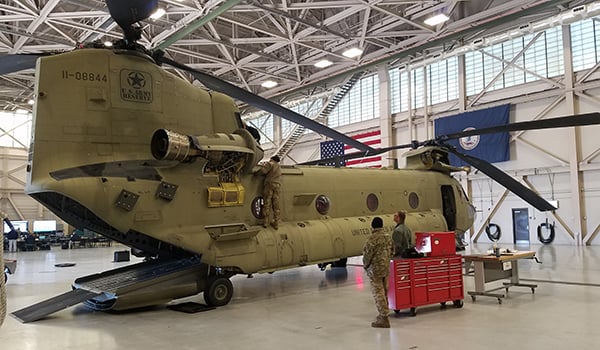
By COL Andrew Cecil and Robert Singler: The Army Reserve’s (AR) CH-47F fleet consistently meets or exceeds Department of the Army (DA) standards in Operational Readiness (OR) rates.
The average AR CH-47F fleet OR rate for 2018 was 79% and for 2019 it was 82% Making 2019’s OR rate even more impressive is the fact that the AR Aviation Support Facilities (ASF) are operating at 60% of their authorized personnel strength but still maintaining 100% of their CH-47 fleet. The key to this success is effective Mission Command which enables and promotes engaged leadership, unity of effort, pride in ownership, and collaboration.

Aviation Support Facility Eustis and 5-159 General
Support Aviation Battalion (GSAB) Soldiers conduct maintenance on a CH-47F at Fort Eustis, VA. / U.S. ARMY RESERVE PHOTO
The Army Reserve Aviation Command (ARAC) is a unique organization in relation to the U.S. Army Active Component (AC) Combat Aviation Brigades (CAB) or Army National Guard (ARNG) Expeditionary Aviation Brigades (ECAB). It is the only multi Aviation Brigade organization in the Army outside of the Corps. The Command has units geographically dispersed across the nation in 12 states and in 14 different locations, covering all four CONUS time zones. Each of these locations has an ASF with the dual responsibilities of maintaining the fleet of aircraft and providing individual rated and non-rated crew member training. Army Reserve ASFs consist of a civilian workforce under the direction of an ASF Supervisor. This workforce is comprised of military technicians (MILTEC) and Department of the Army Civilians (DAC).An Aviation Program Manager (APM) at the ARAC headquarters enables much of the collaboration and coordination between ASFs which is critical to success. The ARAC is commanded by a brigadier general who provides the vision and resources for a unified organization.
There is no “secret” formula to success. The Army’s principles of Mission Command clearly lay out the ARAC’s path to success. The ASFs and units build cohesive teams through mutual trust. The CG provides clear commander’s intent which fosters a shared understanding. She then empowers her Commanders to exercise disciplined initiative while accepting prudent risk. The ASFs are part of this. They are not separate entities but a part of the whole team. The ARAC is a single entity striving for success and empowered by effective mission command to enable decisions at the lowest level.
Success in maintenance utilizes the same formula as success in combat – power down authority, resources, decision making and flexibility to the lowest level commensurate with risk accountability. Effective Mission Command enables unity of effort, cooperation, and collaboration through effective leadership. Effective Mission Command empowers fourteen separate facilities to manage their own CL IX accounts, budgets, and phase plans based on Commander’s Intent. Every DA Civilian, MILTEC, and Soldier in the ARAC understands that there is only one measure of success – mission accomplishment. Mission Command makes it possible.
COL Andrew D. Cecil is the deputy commanding officer and Mr. Robert F. Singler is the Aviation Program Manager for the Army Reserve Aviation Command at Fort Knox, KY.










